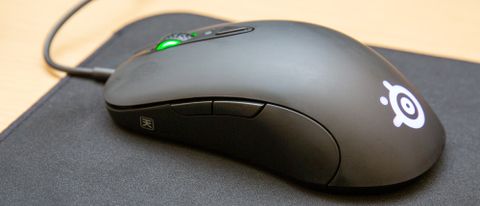Laptop Mag Verdict
A timeless design paired with a modern sensor makes the SteelSeries Sensei Ten an excellent ambidextrous gaming mouse.
Pros
- +
Comfortable, ambidextrous design
- +
Elegant, iconic aesthetics
- +
Premium soft-touch material
- +
Outstanding sensor performance
Cons
- -
No wireless option
- -
Light on features
- -
A bit pricey
Why you can trust Laptop Mag
Some designs don't age. From Converse to Coke bottles, these oft-mimicked products never waver, even as their competitors are modernized with the latest features. In the world of gaming mice, the SteelSeries Sensei is that iconic product. This year, SteelSeries is commemorating its tried-and-true mouse with a 10th anniversary edition.
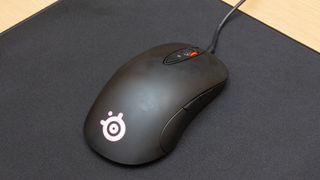
The aptly named Sensei Ten has the same iconic design as its predecessors and marries it with one of the best sensors around. The Sensei Ten nails the basics — but its $70 asking price isn't cheap, and the ambidextrous design, while great for most people, isn't perfect for everyone.
Regardless, if you're looking for a reliable, no-nonsense mouse with excellent performance, the Sensei Ten is one of the best gaming mice you can get.
Design
The Sensei Ten is an elegant gaming mouse with a minimalist design. Because it lacks the flashy elements of other gaming mice, the Sensei Ten looks just as smug in an office as it would at a LAN party.
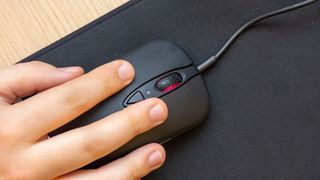
The Sensei Ten's design is simple and refined. The mouse has plain, all-black surfaces disrupted only by an RGB-illuminated SteelSeries logo and an RGB-lined scroll wheel. A small Japanese and Chinese character for heaven is stamped on the inner left side of the mouse as a nod to this anniversary edition. As an ambidextrous mouse, the Sensei Ten has a symmetrical shape that's enhanced by sleek, gentle curves.

Ambidextrous mice don't contour your hand like their less-flexible counterparts. And yet, the Sensei Ten is one of the most comfortable mice I've used. The inward curves on the sides of the mouse gave my thumb and ring finger a natural place to rest, while my wrists appreciated the low-profile design and easy-to-reach scroll wheel. The obvious benefit of an ambidextrous design is that it accommodates both left- and right-handed folks. Another perk is that it suits a wide range of gamers who use claw, finger or palm grips.
Because it lacks the flashy elements of other gaming mice, the Sensei Ten would look just as smug in an office as it would at a LAN party.
My favorite thing about the Sensei Ten is its soft-touch matte finish. In addition to making the mouse supercomfortable to hold, the surface gives the Sensei a certain sophistication you don't typically find in gaming peripherals.
SteelSeries also nailed the weight and balance of the Sensei Ten. The mouse is lightweight, at 92 grams (3.25 ounces), but it still feels substantial. And at 5 x 2.7 x 1.5 inches, the Sensei Ten is a medium-sized mouse that shouldn't cause problems for most people.
MORE: Best Gaming Mouse | Laptop Mag
This is an eight-button mouse with a pretty standard layout: left- and right-click buttons up front, a pair of shortcut buttons on each side and a button for switching DPI (dots per inch) on top, just above a low-profile scroll wheel.
Features
The Sensei Ten is meant for competitive gaming, so you won't get all the bells and whistles offered by some of its rivals. You can think of the Sensei Ten as an F1 race car; it prioritizes speed, so anything extra gets stripped away.
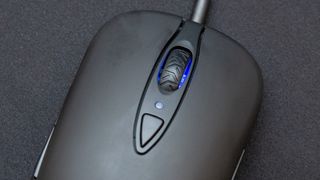
Using that comparison, the engine inside the Sensei Ten is a TrueMove Pro optical sensor that tracks movements at up to 18,000 DPI at a 1,000-Hz-per-millisecond polling rate. The max gravitational force is set at 50G acceleration, while IPS (inches per second) tops out at 450 on a QcK mouse pad.
SteelSeries also beefed up the durability for this 10th-anniversary mouse: The company says its mechanical switches can survive at least 60 million clicks.
Customization is done through the SteelSeries Engine 3 software. Free on macOS and Windows 10, the app is where you can assign buttons, adjust the RGB lighting and choose a DPI or CPU (between 50 and 18,000). Granular controls let you tinker with polling rates, angle snapping and acceleration/deceleration.
Most folks won't need to touch those settings, but it's a nice thing to have if you're a competitive gamer. If you'd like to set it and forget it, you can set an infinite number of profiles (for lighting, DPI, etc.) on your PC or five profiles assigned on the Sensei Ten's onboard memory.
MORE: Best and Worst Laptop Gaming Brands
The app is easy to use, and the Live Preview option is a useful tool. But it would have been cleaner to have all of the aforementioned adjustments on multiple tabs instead of one cluttered page. Also, certain interfaces, like the pop-up box for changing the RGB lighting, could use a modern overhaul.
Performance
The Sensei Ten is a delight to use. The TrueMove Pro optical sensor is responsive and fast, and the mouse is comfortable to hold and glides effortlessly on SteelSeries' own QcK mouse pad.
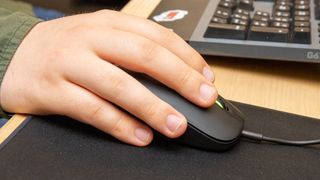
My Victory Royale rate didn't exactly skyrocket, but the precision of the Sensei Ten's sensor allowed me to play at a higher DPI. I consistently and accurately fired off the crucial first shotgun round at my foes before they could react, thanks to how fast I could move my gun without losing control.
The Sensei Ten is a delight to use.
The clicky buttons helped me slash my way through a horde of orcs in Middle-earth: Shadow of War, allowing me to quickly switch between swinging my sword with a left click and blocking incoming attacks with a right click.
MORE: The 14 Most Gorgeous and Demanding PC Games | Laptop Mag
I tested the sensitivity of the optical sensor by using the Sensei Ten on various surfaces. No matter where I played — on a mouse pad, a wooden desk, a box or even my jeans — my cursor glided smoothly across the screen without any skipping.
Bottom line
SteelSeries took its iconic Sensei mouse and paired it with one of the best sensors around, creating a mouse that's great for both professional players and casual gamers. Combine excellent performance with a sleek design, comfortable soft-touch finish and responsive buttons, and we have no choice but to give the Sensei Ten our highest recommendation.
There are only a couple of reasons you might choose a different mouse. The first is the Sensei Ten's $70 price, which is a bit high. Second, the Sensei Ten is for minimalist gamers who want a streamlined experience. If you'd prefer the latest features or a more aggressive design, you might consider the Logitech G502 Proteus Core or the HP Omen Photon.
All things considered, the Sensei Ten is an excellent mouse for most gamers and a deserving celebration of a legendary gaming peripheral.
Phillip Tracy is the assistant managing editor at Laptop Mag where he reviews laptops, phones and other gadgets while covering the latest industry news. After graduating with a journalism degree from the University of Texas at Austin, Phillip became a tech reporter at the Daily Dot. There, he wrote reviews for a range of gadgets and covered everything from social media trends to cybersecurity. Prior to that, he wrote for RCR Wireless News covering 5G and IoT. When he's not tinkering with devices, you can find Phillip playing video games, reading, traveling or watching soccer.
